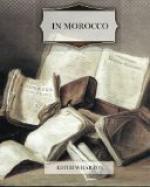M. Tranchant de Lunel has pointed out (in “France-Maroc”) with what a sure sense of suitability the Merinid architects adapted this decoration to the uses of the buildings. On the lower floor, under the cloister, is a revetement of marble (often alabaster) or of the almost indestructible ceramic mosaic.[A] On the floor above, massive cedar-wood corbels ending in monsters of almost Gothic inspiration support the fretted balconies; and above rise stucco interfacings, placed too high up to be injured by man, and guarded from the weather by projecting eaves.
[Footnote A: These Moroccan mosaics are called zellijes.]
[Illustration: From a photograph from the Service des Beaux-Arts au Maroc
Sale—interior court of the Medersa]
The private house, whether merchant’s dwelling or chieftain’s palace, is laid out on the same lines, with the addition of the reserved quarters for women; and what remains in Spain and Sicily of Moorish secular architecture shows that, in the Merinid period, the play of ornament must have been—as was natural—even greater than in the medersas.
The Arab chroniclers paint pictures of Merinid palaces, such as the House of the Favourite at Cordova, which the soberer modern imagination refused to accept until the medersas of Fez were revealed, and the old decorative tradition was shown in the eighteenth century Moroccan palaces. The descriptions given of the palaces of Fez and of Marrakech in the preceding articles, which make it unnecessary, in so slight a note as this, to go again into the detail of their planning and decoration, will serve to show how gracefully the art of the mosque and the medersa was lightened and domesticated to suit these cool chambers and flower-filled courts.
With regard to the immense fortifications that are the most picturesque and noticeable architectural features of Morocco, the first thing to strike the traveller is the difficulty of discerning any difference in the probable date of their construction until certain structural peculiarities are examined, or the ornamental details of the great gateways are noted. Thus the Almohad portions of the walls of Fez and Rabat are built of stone, while later parts are of rubble; and the touch of European influence in certain gateways of Meknez and Fez at once situate them in the seventeenth century. But the mediaeval outline of these great




